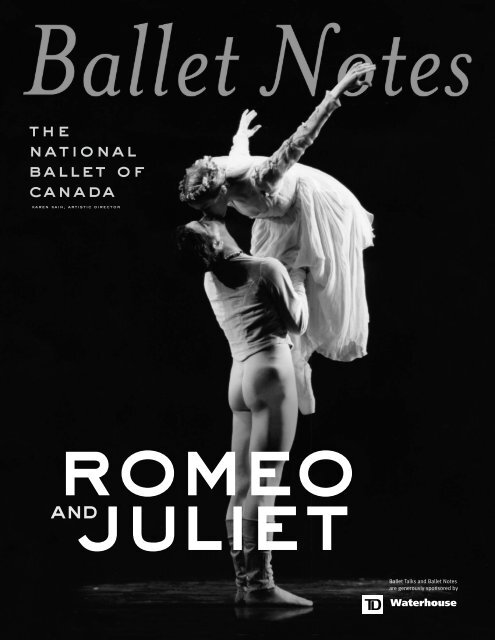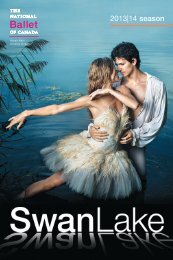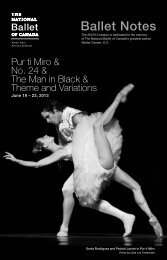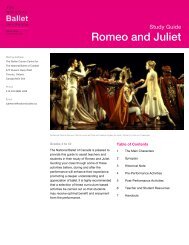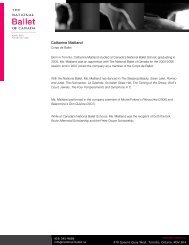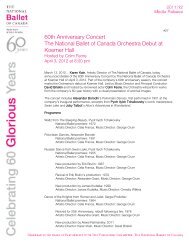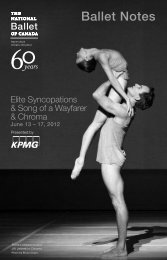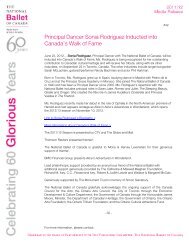ROMEO Notes - The National Ballet of Canada
ROMEO Notes - The National Ballet of Canada
ROMEO Notes - The National Ballet of Canada
Create successful ePaper yourself
Turn your PDF publications into a flip-book with our unique Google optimized e-Paper software.
the<br />
national<br />
ballet <strong>of</strong><br />
canada<br />
karen kain, artistic director<br />
romeo<br />
juliet<br />
and<br />
<strong>Ballet</strong> Talks and <strong>Ballet</strong> <strong>Notes</strong><br />
are generously sponsored by
Two households, both alike in dignity,<br />
In fair Verona, where we lay our scene ...<br />
WILLIAM SHAKESPEARE’S PLAY<br />
John Cranko’s ballet, Romeo and Juliet, is one <strong>of</strong> the happiest marriages<br />
<strong>of</strong> literature and dance. Behind every movement, gesture,<br />
duet and interlude, the poetry <strong>of</strong> William Shakespeare is whispered<br />
throughout the ballet.<br />
This timeless tale <strong>of</strong> star-crossed love, however, did not originate<br />
with Shakespeare. <strong>The</strong> story has its roots in folklore and a version<br />
<strong>of</strong> it dates back as early as the 3rd century AD, in the tale <strong>of</strong> Ephesiaca<br />
by Xenophon <strong>of</strong> Ephesus. In this story, Anthia is separated from<br />
her husband and is rescued from robbers by Perilaus. To avoid<br />
marrying Perilaus, she obtains from a physician a sleeping potion<br />
that she believes to be a mortal poison. But Anthia awakens in the<br />
tomb and is carried <strong>of</strong>f by tomb-robbers to further adventures.<br />
Some also believe the story <strong>of</strong> Romeo and Juliet to be based on real<br />
people and events. In the 13th century there were families named<br />
Montecchi and Capelletti that belonged to different political<br />
factions and the Montecchi did live in Verona.<br />
In the 17th century, commercial playwrights like Shakespeare were<br />
expected to churn out plays for the multitude <strong>of</strong> theatre-goers in<br />
Elizabethan London in great quantities. To accommodate the high<br />
demand for his work, originality was secondary to production,<br />
and it was common for many playwrights to re-work existing plays,<br />
borrowing from and improving on their stories. Shakespeare’s<br />
production <strong>of</strong> the play was first performed in the 1590s under<br />
the title <strong>of</strong> <strong>The</strong> Tragical Historye <strong>of</strong> Romeus and Juliet.<br />
Shakespeare made a number <strong>of</strong> alterations to these stories. His<br />
play’s action takes place during a few days rather than a few weeks.<br />
He also invented the character <strong>of</strong> Mercutio and the sword-fight<br />
between Tybalt and Romeo. Shakespeare’s Juliet is also much<br />
younger than those found in previous versions <strong>of</strong> the story. His<br />
Juliet is nearly 14, on the brink <strong>of</strong> womanhood but still a child<br />
and experiencing first love. One should keep in mind that in<br />
Shakespeare’s day, marriage at 14 was not uncommon. Shakespeare<br />
thus made Romeo and Juliet his own, and <strong>of</strong> all known versions, his<br />
has become the most well known, and universally acknowledged<br />
as a great work <strong>of</strong> literature.
omeo<br />
juliet<br />
and<br />
a ballet in three acts after<br />
william shakespeare<br />
Choreography by John Cranko<br />
Originally staged by Reid Anderson<br />
Reproduced from Benesh Notation<br />
by Jane Bourne (1993)<br />
Copyright Dieter Graefe<br />
Music Sergei Prok<strong>of</strong>iev<br />
Set & Costume Design Susan Benson<br />
Assistant to Miss Benson<br />
Marjory Fielding<br />
Lighting Design Robert Thomson<br />
This production entered the repertoire <strong>of</strong> <strong>The</strong> <strong>National</strong><br />
ballet <strong>of</strong> <strong>Canada</strong> on February 8, 1995 and was totally<br />
underwritten by Walter Carsen, O.C.<br />
Walter Carsen is proud to be able to play a part in<br />
presenting the outstanding choreography <strong>of</strong> John<br />
Cranko and would like to dedicate these performances<br />
to his memory.<br />
Presented by<br />
cover photo: guillaume côté as romeo and heather ogden as juliet,<br />
opposite: guillaume côté as romeo, peter ottmann as friar laurence and<br />
heather ogden as juliet.
synopsis<br />
Act I Scene 1 A Street in Verona, Italy<br />
<strong>The</strong> scene is set in the early Renaissance, about 1400.<br />
Romeo, son <strong>of</strong> Lord Montague, is infatuated with<br />
Rosalind and flirts with her in the courtyard. <strong>The</strong> city<br />
begins to awaken and the townspeople open the market<br />
for trade. But all is not peaceful. <strong>The</strong> city’s two most<br />
powerful families, the Capulets and the Montagues,<br />
are feuding bitterly. Playful teasing soon turns into a<br />
brawl as members <strong>of</strong> the opposing families draw swords<br />
and begin to fight. Romeo joins his friends, Mercutio<br />
and Benvolio, and the three become involved in the<br />
brawl. <strong>The</strong> riot is quelled by the arrival <strong>of</strong> the Duke <strong>of</strong><br />
Verona, who decrees the death penalty if either family<br />
disturbs the peace again.<br />
Scene 2 <strong>The</strong> Capulet’s Garden<br />
Juliet, the young daughter <strong>of</strong> Lord Capulet, plays with<br />
her Nurse. Her mother joins them bringing Juliet the<br />
dress she is to wear that evening to her first ball. Excited,<br />
Juliet dances about with her dress, but stops suddenly<br />
when she realizes that her carefree childhood is coming<br />
to an end.<br />
Scene 3 <strong>The</strong> Foyer <strong>of</strong> the Capulet’s Palace<br />
Elegant guests arrive at the ball. Although not invited,<br />
Romeo, Mercutio and Benvolio boldly make their way<br />
into the foyer, cloaked and masked as revellers.<br />
Scene 4 <strong>The</strong> Capulet’s Ballroom<br />
Juliet shyly arrives at the ball and is introduced to Count<br />
Paris, to whom she is betrothed. While Juliet is dancing<br />
with Paris, she and Romeo see one another for the first<br />
time and fall in love. <strong>The</strong>y steal a few moments together<br />
away from the guests until Tybalt, Juliet’s cousin,<br />
recognizes Romeo and challenges him to a duel. Lord<br />
Capulet stops the disturbance.<br />
Scene 5 Juliet’s Balcony<br />
Later the same night Romeo hides in the Capulet’s garden<br />
and overhears Juliet pr<strong>of</strong>essing her love for him. Romeo<br />
reveals himself to Juliet and the young lovers swear their<br />
eternal devotion.<br />
act II Scene 1 A Street in Verona<br />
Verona is celebrating a festive holiday. Juliet’s Nurse finds<br />
her way through the crowd in search <strong>of</strong> Romeo to give him<br />
a note from her mistress. Juliet has agreed to meet Romeo<br />
secretly in Friar Laurence’s cell where they can be married.<br />
Scene 2 Friar Laurence’s Cell<br />
Friar Laurence marries the young lovers, hoping that this<br />
will end the feud between their two families.<br />
Scene 3 A Street in Verona<br />
<strong>The</strong> festivities are interrupted by Tybalt, who is intent<br />
upon resuming his quarrel with Romeo. Romeo, however,<br />
is aware that Juliet’s relatives are now his own, so he avoids<br />
a duel with Tybalt. Mercutio, appalled at his friend’s<br />
apparent lack <strong>of</strong> spirit, accepts Tybalt’s challenge on<br />
Romeo’s behalf. In attempting to stop the fight, Romeo<br />
inadvertently causes Mercutio’s death. Shocked out <strong>of</strong><br />
his peaceful resolution, Romeo kills Tybalt, avenging<br />
his friend. Lady Capulet witnesses the death, and grieves<br />
over her dead nephew.<br />
.
ACT III Scene 1 Juliet’s Bedroom<br />
Romeo, banished from Verona for killing Tybalt, has<br />
remained for his wedding night with Juliet. At dawn,<br />
he is forced to leave. Juliet’s parents enter with Paris<br />
and inform her that she is to marry Paris the next day.<br />
In desperation Juliet hurries away to seek advice from<br />
Friar Laurence.<br />
Scene 2 Friar Laurence’s Cell<br />
Reluctantly, Friar Laurence gives Juliet a vial containing<br />
a sleeping potion that will induce a death-like coma.<br />
He will send a message to Romeo, telling him what has<br />
happened, and he will return to rescue her from the<br />
family vault.<br />
Scene 3 Juliet’s Bedroom<br />
Filled with fear and doubts, Juliet forces herself to<br />
drink the potion and falls unconscious on the bed.<br />
In the morning Juliet’s bridesmaids arrive to present<br />
her with flowers. Lady Capulet and the Nurse are unable<br />
to wake Juliet and presume she is dead.<br />
Scene 4 <strong>The</strong> Capulet Vault<br />
Juliet is laid to rest in the Capulet Vault. Romeo has<br />
heard <strong>of</strong> Juliet’s death, but has not received Friar<br />
Laurence’s explanatory letter. He hurries to her tomb<br />
and finds Paris there. In desperation Romeo kills Paris.<br />
Believing Juliet to be dead, Romeo takes his own life.<br />
Juliet, recovering from the potion, is horrified to find<br />
Romeo dead beside her. Unable to live without him,<br />
she joins him in death.<br />
opposite: clockwise from top left: artists <strong>of</strong> the ballet; christopher<br />
body as tybalt, keiichi hirano as benvolio, piotr stanczyk as mercutio<br />
and guillaume côté as romeo; victoria bertram as lady capulet and<br />
heather ogden as juliet. this page: heather ogden as juliet and guillaume<br />
côté as romeo.<br />
..never was a story <strong>of</strong> more woe<br />
Than this <strong>of</strong> Juliet and her Romeo
JOHN CRANKO’S BALLET<br />
John Cranko, the creator <strong>of</strong> such masterful story ballets<br />
as Onegin and <strong>The</strong> Taming <strong>of</strong> the Shrew, staged his production<br />
<strong>of</strong> Romeo and Juliet for <strong>The</strong> <strong>National</strong> <strong>Ballet</strong> <strong>of</strong> <strong>Canada</strong> in<br />
the spring <strong>of</strong> 1964.<br />
Cranko was working in England with the Sadler’s Wells<br />
<strong>Ballet</strong> when Russia’s Bolshoi <strong>Ballet</strong> made its first visit to<br />
London in 1956. Cranko witnessed both the technical<br />
skills and great artistry <strong>of</strong> the Russian dancers, as well as<br />
their renowned production <strong>of</strong> Romeo and Juliet at Covent<br />
Garden. It was this production that inspired Cranko to<br />
create his own version <strong>of</strong> the ballet.<br />
Cranko first staged William Shakespeare’s play as a ballet<br />
in 1958 for the ballet company <strong>of</strong> La Scala, Milan. <strong>The</strong><br />
premiere <strong>of</strong> this production took place on July 26, 1958,<br />
at the open-air amphitheatre Teatro Verde on the island<br />
<strong>of</strong> San Giorgio in Venice, Italy. <strong>The</strong> sets for the production<br />
were by Nicola Benois, son <strong>of</strong> the <strong>Ballet</strong>s Russes designer<br />
Alexandre Benois.<strong>The</strong>re Cranko cast a very young, unknown<br />
ballerina, the 21-year-old Carla Fracci, in the role <strong>of</strong> Juliet.<br />
On December 2, 1962, Cranko staged a new version <strong>of</strong><br />
the ballet for his own company, the Stuttgart <strong>Ballet</strong>. This<br />
production featured sets and costumes by a young German<br />
designer, Jürgen Rose, marking the beginning <strong>of</strong> many<br />
future collaborations between choreographer and designer.<br />
For his Juliet, Cranko cast the young Marcia Haydée,<br />
who was soon to be hailed as one <strong>of</strong> the world’s leading<br />
dramatic ballerinas.<br />
In 1964, Cranko travelled toToronto to mount Romeo<br />
and Juliet on <strong>The</strong> <strong>National</strong> <strong>Ballet</strong> <strong>of</strong> <strong>Canada</strong>. He was an old<br />
friend and colleague <strong>of</strong> the company’s founding Artistic<br />
Director, Celia Franca. <strong>The</strong> Canadian premiere <strong>of</strong> the<br />
<strong>National</strong> <strong>Ballet</strong>’s production <strong>of</strong> Cranko’s Romeo and Juliet<br />
took place at Montréal’s Place des Arts on April 14, 1964,<br />
with guest artists from the Stuttgart <strong>Ballet</strong>, Marcia Haydée<br />
and Ray Barra, in the title roles and with Celia Franca as<br />
Lady Capulet. Commenting on that opening night in<br />
Montréal, Sydney Johnson wrote in the Montréal Star:<br />
“As far as I am concerned, last night was the greatest night<br />
in the 13-year history <strong>of</strong> <strong>The</strong> <strong>National</strong> <strong>Ballet</strong> <strong>of</strong> <strong>Canada</strong>.”<br />
<strong>The</strong> company then took Romeo and Juliet home to Toronto<br />
and marked the <strong>National</strong> <strong>Ballet</strong>’s debut at the O’Keefe<br />
Centre (now the Hummingbird Centre). It was the first<br />
large-scale 20th-century ballet as well as the most lavish<br />
to enter the company’s repertoire and was deliberately<br />
chosen to suit the large stage <strong>of</strong> the O’Keefe Centre.<br />
<strong>The</strong> first Toronto performance, on April 21, 1964, starred<br />
Galina Samsova and Earl Kraul in the leading roles. So<br />
successful was this production that it was filmed for<br />
television in 1965 by Norman Campbell starring 19-yearold<br />
Veronica Tennant as Juliet and Earl Kraul as Romeo.<br />
<strong>The</strong> production won the Prix René Barthelemy at the<br />
International Television Festival in Monte Carlo in 1966.<br />
Throughout the late 1960s and early 1970s, the <strong>National</strong><br />
<strong>Ballet</strong> garnered international praise for its performances<br />
<strong>of</strong> Romeo and Juliet, touring the production to Expo ‘70 in<br />
Osaka, Japan, to Washington, D.C., Mexico City and<br />
throughout <strong>Canada</strong>. However in 1973, a fire in the<br />
<strong>National</strong> <strong>Ballet</strong>’s wardrobe department destroyed all <strong>of</strong> the<br />
sets and costumes for Romeo and Juliet and the ballet, which had<br />
become a signature piece for the company, left the repertoire.<br />
In 1976, as part <strong>of</strong> the <strong>National</strong> <strong>Ballet</strong>’s 25th anniversary<br />
celebrations, Romeo and Juliet was revived. It was first<br />
performed at the Olympic Arts Festival in Montréal in July<br />
<strong>of</strong> 1976 and later performed in Toronto that November.<br />
For a special performance on November 14, 1976 many<br />
former <strong>National</strong> <strong>Ballet</strong> dancers came out <strong>of</strong> retirement to<br />
appear in the performance: Lilian Jarvis danced the role <strong>of</strong><br />
Juliet, Hazaros Surmeyan danced Romeo, Yves Cousineau<br />
played Tybalt and Celia Franca appeared as Lady Capulet.<br />
Romeo and Juliet was re-designed to spectacular effect by Susan<br />
Benson in 1995 and it is this production that the company<br />
dances today.This season, Romeo and Juliet marks the <strong>National</strong><br />
<strong>Ballet</strong>’s final performances at the Hummingbird Centre<br />
before moving to the Four Seasons Centre for the<br />
Performing Arts.<br />
this page: veronica tennant as juliet and earl kraul as romeo in the cbc<br />
production, 1965; celia franca as lady capulet and lilian jarvis as juliet, 1976.<br />
opposite: sonia rodriguez as juliet.<br />
photos by barry gray, andrew oxenham, cylla von tiedemann
SERGEI PROKOFIEV’S MUSIC<br />
“I have taken special pains to achieve a simplicity which will,<br />
I hope, reach the hearts <strong>of</strong> all listeners. If people find no melody<br />
or no emotion in this work <strong>of</strong> mine, I shall feel very sorry;<br />
but I am sure that they will sooner or later.”<br />
— Sergei Prok<strong>of</strong>iev on Romeo and Juliet<br />
Today Sergei Prok<strong>of</strong>iev’s score for Romeo and Juliet is considered<br />
to be the quintessential rendering <strong>of</strong> William Shakespeare’s<br />
timeless tale and one <strong>of</strong> the most popular <strong>of</strong> all ballet compositions.<br />
However, Prok<strong>of</strong>iev’s original composition <strong>of</strong> Romeo<br />
and Juliet was heavily criticized and it was many years before it<br />
was finally accepted and performed by a ballet company.<br />
In 1934, the Russian-born Prok<strong>of</strong>iev was commissioned by<br />
the Kirov <strong>The</strong>atre in Leningrad to write a score, possibly<br />
based on Shakespeare’s Romeo and Juliet, to be choreographed<br />
by Rostislav Zacharov. <strong>The</strong> Communist regime demanded<br />
that the end <strong>of</strong> Shakespeare’s play be changed and that the<br />
ballet be given a happy ending, to which Prok<strong>of</strong>iev took<br />
<strong>of</strong>fence.<strong>The</strong> score was written specifically as narrative dancedrama<br />
and was meticulously matched to the scenario by<br />
Prok<strong>of</strong>iev and the Kirov’s stage director, Sergey<br />
Radlov. It was to be a lavish, spectacular production<br />
and Prok<strong>of</strong>iev’s first full-length<br />
ballet.<br />
Though Prok<strong>of</strong>iev’s score was<br />
completed on September<br />
8, 1935, problems soon<br />
led to the Kirov <strong>The</strong>atre<br />
backing out <strong>of</strong> the project.<br />
<strong>The</strong> ballet was then to<br />
be staged by Moscow’s<br />
Bolshoi <strong>The</strong>atre. However,<br />
the Bolshoi found<br />
the music unsuitable<br />
for dance and rejected it.<br />
<strong>The</strong> dancers, used to the<br />
tuneful dance rhythms <strong>of</strong><br />
Tchaikovsky, had difficulty<br />
with Prok<strong>of</strong>iev’s unconventional<br />
rhythms and orchestration.<br />
<strong>The</strong> first performance <strong>of</strong> Romeo<br />
and Juliet to Prok<strong>of</strong>iev’s music took<br />
place in Brno, Czechoslovakia,<br />
on December 30, 1938, with<br />
choreography by the little-known<br />
Vania Psota. Two years later, the<br />
Kirov <strong>Ballet</strong>, following numerous<br />
discussions with Prok<strong>of</strong>iev and<br />
alterations in the score, premiered<br />
Romeo and Juliet to choreography by<br />
Leonid Lavrovsky. <strong>The</strong> score was<br />
considered radical by many Russian<br />
musicians, who feared the worst upon the ballet’s premiere.<br />
<strong>The</strong> time was nonetheless right, and the ballet proved a<br />
resounding success and was later staged in Moscow by the<br />
Bolshoi <strong>Ballet</strong> in 1946.<br />
Few composers have created full-length ballet scores, particularly<br />
in the 20th century. As such, Prok<strong>of</strong>iev follows in the<br />
tradition <strong>of</strong> such well-known ballet composers as Tchaikovsky.<br />
Writes choreographer Lavrovsky: “Prok<strong>of</strong>iev carried on<br />
where Tchaikovsky left <strong>of</strong>f. He developed and elaborated the<br />
principles <strong>of</strong> symphonism in ballet music.” <strong>The</strong> score for<br />
Romeo and Juliet is both dramatic and symphonic, not unlike<br />
Tchaikovsky’s scores for Swan Lake and <strong>The</strong> Sleeping Beauty. But,<br />
whereas Tchaikovsky gave musical selections dance names –<br />
pas de deux, pas de cinq, Russian dance – and interspersed<br />
his work with entertaining dance divertissements, Prok<strong>of</strong>iev<br />
linked his composition <strong>of</strong> 53 sections or items with the<br />
dramatic rather than the dance elements, naming his musical<br />
selections after the characters and situations they depicted.<br />
So Romeo and Juliet’s plot and music are closely intertwined;<br />
its dances are not simply entertainment but an integral part<br />
<strong>of</strong> the drama.<br />
As in Adolphe Adam’s score for Giselle, musical leitmotifs,<br />
portraits <strong>of</strong> the characters, are also prevalent in Romeo and Juliet,<br />
though in a less structured fashion and with greater variance<br />
and levels <strong>of</strong> depth. <strong>The</strong>se leitmotifs include seven distinct<br />
themes for Juliet that outline various aspects <strong>of</strong> her<br />
developing personality and<br />
that incorporate slow<br />
tempi, strings and<br />
woodwinds. From the<br />
moment Prok<strong>of</strong>iev<br />
introduces her, Juliet<br />
is a girl brimming<br />
with youthful play<br />
but overshadowed<br />
by a foreboding<br />
doom. Prok<strong>of</strong>iev<br />
carefully creates<br />
atmosphere in his<br />
composition, from the<br />
lively, robust street scenes<br />
<strong>of</strong> Verona, to the lush and<br />
romantic love duets. <strong>The</strong> music<br />
for the first meeting <strong>of</strong> Romeo and<br />
Juliet is a madrigal, a love poem with a<br />
cantabile theme for violins and violas. Suddenly,<br />
Prok<strong>of</strong>iev has turned a young, playful girl into a<br />
woman in love. Later, in the balcony scene, their<br />
love is furthered in a lyrical adagio and bonded in<br />
a marriage scene that combines both the calm <strong>of</strong><br />
their reason and their foreboding tragedy. It culminates<br />
in the bedroom scene, which also becomes<br />
their farewell. by sharon vanderlinde<br />
the national ballet <strong>of</strong> canada<br />
<strong>The</strong> Walter Carsen Centre for the national ballet <strong>of</strong> canada<br />
470 Queens Quay West, Toronto, Ontario m5v 3k4 416-345-9686<br />
national.ballet.ca


